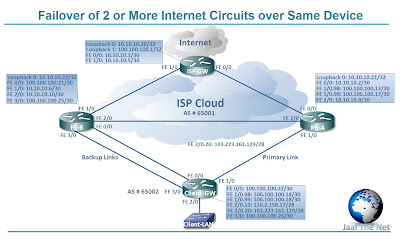Scenario:
This topology elaborates MPLS L3 VPN provisioning using Cisco's IOS, Juniper's Junos & Huawei's VRP (Versatile Routing Platform Software) based PE routers using different PE-CE routing protocols.
· The ISP’s core is using ISIS as IGP.
· MPLS (LDP) runs on top of ISIS.
· The RR JUNOS router is functioning as Route Reflector for Junos-PE, IOS-PE & VRP-PE.
· The three PEs have MP-BGP relation with RR JUNOS.
· The client has 3 sites running different platforms, i.e., IOS-CE, JUNOS-CE, VRP-CE.
· PE-CE protocol between JUNOS-PE and IOS-CE is OSPF.
· PE-CE protocol between IOS-PE and JUNOS-CE is eBGP.
· PE-CE protocol between VRP-PE & VRP-CE is ISIS.
Platforms used in this topology are:
IOS-PE = Cisco IOS Software, 3600 Software (C3640-JK9O3S-M), Version 12.4(16a) running in GNS3
IOS-CE = Cisco IOS Software, 2600 Software (C2691-ADVENTERPRISEK9-M), Version 12.4(5a) running in GNS3
All JUNOS routers= Model: olive, JUNOS Base OS Software Suite [12.1R1.9] running in GNS3
VRP-PE = Huawei Versatile Routing Platform Software VRP (R) software, Version 5.120 (AR2200 V200R003C01SPC900) running on Huawei AR2220 Router
VRP-CE = Huawei Versatile Routing Platform Software. Software Version : USG2110 00R001C00SPCa00 (VRP (R) Software, Version 5.30) running on Secospace USG2110-F-W
Configuration Files & Routing Tables:







